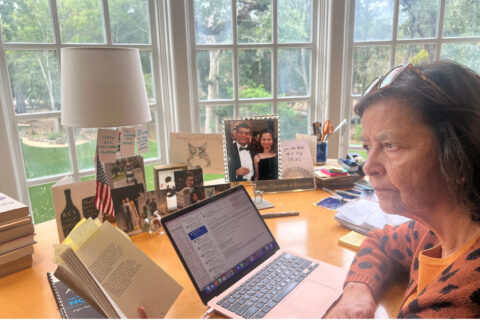
Innovation is Small and Simple
My journey with innovation began at the age of 30 when I was granted my first patent, not because I set out to invent something groundbreaking but because I had a simple idea. From attaining that first patent to launching a ground-breaking telecommunications company, I learned that innovation should not be complicated. This sounds counterintuitive. But making things complicated is almost always the opposite of innovating.
Innovation is often described as a new way of doing old things—or is it? At its core, innovation is transforming ideas into practical solutions that advance technology. If we are lucky, the advances also improve our lives and make it easier to do things. In the best case, the advances allow us to do things we could not even do before. For example, the concept of video conferencing was impossible before high-bandwidth data networks. What I learned in my innovation journey is to look for simple ways to advance technology that would have the most impact.
Innovation Culture Means Trying New Things
My second engineering job was at Bell-Northern Research (BNR) in Silicon Valley. BNR was a research and development lab jointly owned and operated by two Canadian telecommunications firms, Bell Canada and Northern Telecom. The culture of innovation at BNR was strong. Some amazing people worked there. Whitfield Diffie, a pioneer in encryption algorithms, worked there. So did Robert Gaskins, the engineer who invented PowerPoint. BNR was at the forefront of transforming telecommunications systems from hard-wired hardware switches to digital systems built on semiconductors and run by software. At BNR, getting a patent was a big deal. It meant you had a good idea that upper management thought was worthwhile.
Innovation had not yet made the leap from the central switch to the desktop phone. Back then, all phones were large and clunky, and most were black. The large size and heavy weight were necessary to contain the analog components. Phones were a combination of giant microphones and musical instruments. They had to make analog sounds and detect specific tones associated with numbers in order to make a call.
I disliked those giant phones. They were ugly and took up too much space. But I had an idea. What if we could take those massive doorstops and change the way they detected sound from an analog sound to a digital signal that did not require a large sound detection hardware component? What if the whole phone could be shrunk, made lighter and more convenient? Desktop phones could then be much cheaper.
So I was working on a concept to digitally detect the sound each number makes on a phone when dialed. I managed to secure funding to explore this idea further. To my surprise, when I demonstrated a successful working concept to my boss’s boss, he immediately connected me with a patent attorney. At that moment, I didn’t know the extent of the impact my invention could have in the big picture. It later went on to become a core part of the ideas of how digital phone systems work. Today, of course, all modern phones generate sounds and detect numbers dialed digitally.
How Solving A Simple Problem Can Lead to Bigger Things
In my mind, it was a simple problem that required a simple solution — a transistor. What I realized much later was that anything that could be digitized could be played on a semiconductor chip. Semiconductors were getting cheaper, faster, and better all the time, thanks to something we call Moore’s Law (the basic rule of thumb that semiconductors double in power and halve in price every 18 months). So, building systems atop semiconductors would almost automatically make them faster, cheaper, and more power-efficient. This is the underlying principle of the digital age, and it was obvious and useful long before we were concerned about power savings as a step towards climate change.
Take, for example, the monumental task of sending a man to the Moon. This achievement wasn’t the result of a single, earth-shattering invention but rather a series of small innovations. Storing oxygen for long-duration space travel, escaping Earth’s orbit, soft landing on the moon of a rocket-propelled vehicle, and overcoming human challenges in a zero-gravity environment—how to eat, sleep, and even handle basic bodily functions—were all incremental steps. Each of these challenges required innovative, smaller solutions. Those solutions collectively made the moon landing possible.
We idolize inventors as big thinkers and geniuses. That’s a mistake. Their genius often comes from the ability to think small and think simple. Thomas Edison and Henry Ford, two of the most innovative thinkers in history, thought in small improvements that led to big results. The best inventors start with a small problem they want to solve to advance their own learnings. Through experimentation, iteration, and collaboration, they solve enough small problems to ultimately lead to a big impact. From a simple innovation like digital sound detection on a phone, we can eventually land on a smartphone that has more power and capability than even the most sophisticated corporate telecommunications systems of the 1980s.
So, if you want to innovate, start with a small problem that you want to solve or start breaking down a bigger problem into many smaller problems.








Shailendra K Jain
Hi Didi,
Very inspiring write up. Great to know the vital role you work has played in digital communication. Thanks for sharing.
Shailendra
vinitagupta
Thanks, Shailendra.
Vijay Gupta
There are two major categories of innovations: incremental (or evolutionary) innovations and breakthrough (or revolutionary) innovations. An example of incremental innovation is the work you did for your patent. However, landing on the moon was revolutionary.
One could not just make a series of undirected incremental innovations to land on the moon. A group of people (NASA) had to conceive, envision, plan and execute something never done before that was bold, adventurous, very risky and very expensive. Moreover, they had to create highly focused teams to address each challenge involved in the landing. It was all top down, not bottom up.
Because of the much greater cost, time, and risk involved, very few companies (or countries) invest in breakthrough innovations. Some other examples of breakthrough innovations are: Internet, GPS, iPhone, and the Concorde supersonic airplane.
Jyotsna Gupta
Dear Didi,
Very inspiring article.
There is so much the young generation can learn from you.
Jini
vinitagupta
Thanks you Jini.
Paraj
Hello auntie,
All your columns are very motivating. The way you dive into to topic without a lengthy preface and connect your experiences to what you’re trying to convey makes them very interesting. Keep writing & Sharing! .. 👏🏼👏🏼👏🏼
vinitagupta
Thanks for the help with the graphics, Paraj.